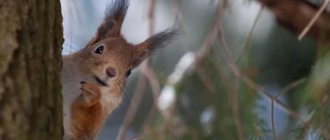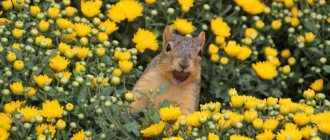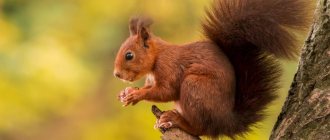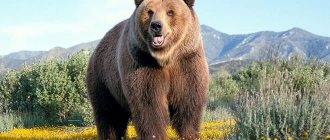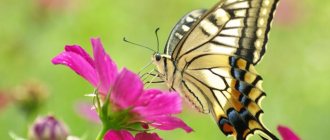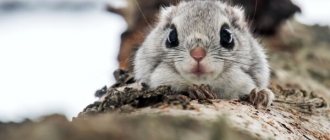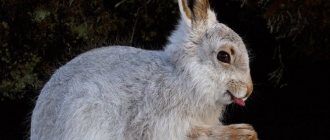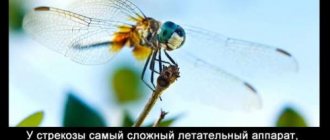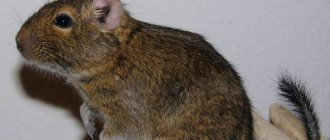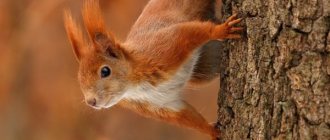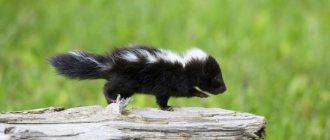The squirrel is not an exotic animal, especially in Russia, where it lives not only in forests, but also in parks, and sometimes just in courtyards. She skillfully uses her charm and loves to beg people for treats so that they can be examined closer. This animal does not live everywhere; for example, they are not found in Australia at all. There is a special type of squirrel - flying squirrels, which have membranes between their legs; these peculiar wings allow them to glide, jumping from tree to tree. Although scientifically they are not squirrels but a species of rodent, their behavior and appearance are very close to those of squirrels.
Appearance
Interesting facts about squirrels - appearance:
- newborn squirrels have sharp claws;
- the hair on the tail changes once a year, the rest of the hair changes twice a year;
- the fluffy tail is not for beauty, it helps control movement when moving along a tree, as well as when jumping;
- teeth grow throughout their lives, because the squirrel constantly gnaws on something (for example, nuts) and the teeth are ground down; if there are no nuts, the animal wears down its teeth on branches;
- funny chinchillas are American squirrels, they are quite active in their homeland, but suffer greatly in captivity from lack of space and the inability to actively move.
Squirrel living environment, housing
The common squirrel is a forest dweller. Due to the fact that this animal usually feeds on tree seeds, it lives mainly in mixed coniferous and deciduous forests. They can also live in spruce and cedar forests, and less often in deciduous forests and mixed pine forests.
Everywhere he finds a way out of the squirrel's situation. Interesting facts about these animals can be supplemented by the fact that in the regions of the Caucasus and Crimea they have even mastered vineyards and orchards.
The animal is very lively and agile, capable of deftly jumping from tree to tree with the help of its tail, which serves as a rudder.
In winter, the common squirrel tries to move only along the treetops, where it hides in case of danger.
The territorial instinct of squirrels is rather weakly expressed, that is, there is no division of the territory into sections.
Shelters are built only on trees. In deciduous forests, the squirrel lives in a hollow, covering itself with a soft bedding of leaves, grass and lichens. The nest usually ranges from five to thirty centimeters in diameter. A common squirrel can occupy a standard birdhouse.
Behavior
Squirrel - interesting facts about behavior:
- They are especially active in the evening and in the morning; during the day they may be sedentary, but if they see people who can give them treats, they become more cheerful;
- keeps a large supply of food for the winter, giving preference to nuts, which are very high in calories and allow the rodent to overwinter without any problems;
- in the wild they live for about four years, at home - about 12 years, but these animals need space, and they suffer a lot in captivity;
- peanuts are harmful to squirrels, you should not give them this product;
- have excellent hearing, the tassels on their ears somehow help them hear better;
- can feed not only on plant foods, but also on small animals, such as chicks and frogs;
- squirrels are loners, but in winter they can gather together to make it easier for them to survive;
- from 2 to 12 baby squirrels are born at a time; they can give birth twice a year;
- the baby squirrel will be born naked and blind, weighing only 8 grams;
- children are fed milk for up to 50 days;
- a two-month-old child leaves his mother;
- for the winter they try to make much more supplies than they need, they hide food in different places, since other animals can ruin the cache;
- squirrels often bury nuts, if she does not eat them in winter, the seeds germinate, thus the animal plants trees, thereby benefiting the environment;
- you need to hand-feed very carefully, since squirrels are carriers of various diseases, including plague, and a rodent can also bite.
Protein Facts 1-10
1. The word “squirrel” comes from the ancient Greek word skiouros, meaning “shadow-tail.” A group of squirrels is called a scurry or dray.
2. Their size varies depending on the species. They can be small, like the common dwarf squirrel or African dwarf squirrel, or large, like the Bhutanese giant flying squirrel.
3. In general, they can range from 10-14 centimeters to 1.27 meters in length. They can weigh from 12-26 grams to over 8 kilograms, like some species of marmots.
4. They have a slender body, bushy tails and large eyes. The fur is soft and the thickness of the fur varies from species to species.
5. The hind limbs are longer than the front ones. The paws sometimes have underdeveloped thumbs and have sharp and powerful claws for climbing and holding on to objects.
6. They live on almost all continents except Antarctica. They can live in almost any habitat, such as tropical forests, temperate forests, semi-deserts, etc. However, they avoid deserts and polar regions.
7. They have vibrissae on their heads and limbs, and therefore have an excellent sense of touch. They have amazing eyesight.
8. Squirrels' teeth follow the shape of rodents' teeth. They have large incisors or front teeth. They continue to grow throughout life.
9. After the incisors there is a gap and then other teeth useful for grinding.
10. Squirrels are herbivores. They cannot digest cellulose and therefore must eat a diet rich in fats, carbohydrates and proteins.
About 30 species have been identified
The genus Sciurus includes about 30 species that live in Asia, America, and Europe. But besides these animals, it is customary to call other representatives of the squirrel family squirrels, for example, red squirrels and palm squirrels. These include Persian, Fire, Yellow-throated, Red-tailed, Japanese and many other squirrels.
Protein Facts 31-40
31. They know the terrain well. They can find alternative routes to food and even discover shortcuts.
32. There are 250 species of squirrels belonging to 50 genera. They live on all continents except Australia and Antarctica.
33. Squirrels communicate using tail movements and chirps. Research has also proven that they observe and learn from others, especially the art of stealing.
34. Flying squirrels don’t fly. They slide. Some of them can fly the length of a football field (about 45 meters or 150 feet, or even 90 meters or 300 feet).
35. Did you know that in nature there are completely white and completely black squirrels? As a rule, these are either fox squirrels or gray squirrels.
Black squirrels, which are the result of melanism. White squirrels are the result of leucism. Places like Brevard, North Carolina have a high ratio of white squirrels.
36. According to a 2010 study, some squirrels chew on a shed rattlesnake and lick its fur to give it a rattlesnake scent. This discourages scent-dependent predators.
37. Not all types of squirrels hibernate—only some do.
38. Squirrel species such as the eastern gray squirrel have become invasive species in Europe, especially in the UK. They threaten smaller red squirrels that are native to the UK.
Squirrels are also invasive to Australia, where there are no native squirrel species.
39. By the mid-19th century, wood-boring squirrels were nearly extinct in the United States. In 1847, Philadelphia saw the first reintroduction of squirrels into the environment. Other places followed suit. By 1880, there were over 1,500 gray squirrels living in Central Park.
Nomadic lifestyle
Even in ancient chronicles it was mentioned that squirrels can migrate . These mass migrations were caused by forest fires or drought, but most often by crop failure. These migrations begin in late summer or early autumn.
Rodents rarely moved far and chose the nearest forest area to live. But there were cases when they moved 250-300 km.
Squirrels roam alone, without forming flocks or aggregations, unless there is a natural obstacle along the way. During such migrations, many of them die from cold and hunger and fall into the clutches of predators.
In addition to mass migrations, there are also seasonal ones, because food in the forests ripens sequentially, squirrels monitor this. Also, at the end of summer - beginning of autumn, young animals begin to settle, moving considerable distances from the nest (70-350 km).
Spend most of their time in trees
Squirrels prefer to stay alone. They spend most of their lives in trees, jumping from one to another . In length, it can cover a distance of up to several meters, which is a lot, considering the size of its body. She can jump down long distances, up to 15 m.
Occasionally it can descend to the ground for food or stored supplies; it also moves along it in jumps up to 1 m long. It descends from trees in the summer, but prefers not to do this in winter.
The squirrel is able to instantly climb trees, clinging to the tree bark with its sharp claws. She can fly up like an arrow to the very top of her head, moving in a spiral.
What do squirrels eat?
The squirrel animal eats walnuts, hazelnuts and chestnuts, as well as pine and spruce seeds. Squirrels also appreciate freshly cut fruits or vegetables, such as small pieces of apples, pears or carrots.
What does a squirrel eat?
- In addition to nuts, rodents also feed on seeds, kernels and fruits, leaves, shoots and buds of plants.
- Squirrels are by no means vegetarians. You can also eat small birds or bird eggs.
- If you want to feed squirrels in winter, you can add hazelnuts, walnuts, and seeds.
- Rodents also love carrots and fruits. They can eat bread and crackers.
Summer food: unshelled nuts, leaves, shoots and buds.
Winter food: shelled nuts, dried fruits, pine cones.
The tail is the real “steering wheel”
The squirrel's tail is equal in length to the main part of its body; it is very long, fluffy and thick. She needs it because... acts as a kind of rudder when she jumps from branch to branch, and also acts as a parachute when she accidentally falls . With it, she can balance and confidently move on the very top of the tree. If the squirrel decides to rest or eat, it becomes a counterweight.
Excellent swimmers
Squirrels can swim, although they prefer not to . But if such a need arises, for example, a flood or fire starts, they rush into the water and swim, trying to reach the shore. Crossing rivers, squirrels gather in flocks, raise their tails and overcome the water obstacles that arise. Some of them drown, the rest reach the shore safely.
Only the common squirrel is found in Russia
In the fauna of our country there is only the common squirrel . She chooses to live in the forests of the European part, as well as the Far East and Siberia, and in 1923 she moved to Kamchatka.
This is a small animal, grows up to 20-28 cm, with a huge tail, weighs less than 0.5 kg (250-340 g). Summer fur is short and sparse, red or brown in color, winter fur is fluffy, tall, gray or black. There are about 40 subspecies of this squirrel. In Russia you can find Northern European, Central Russian, Teleduck and others.
